Menu
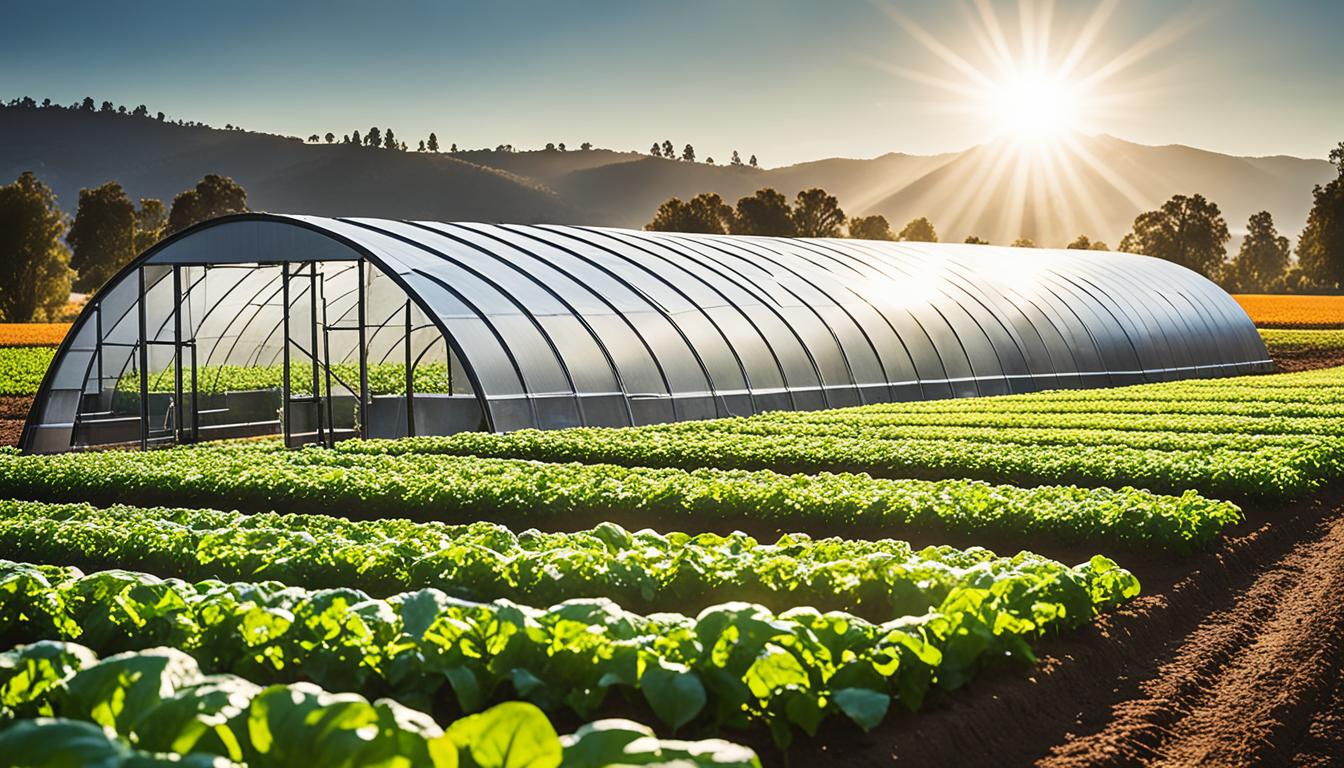
Did you know that 55 percent of new farmland comes from forests and old farms? This big number shows how farming affects deforestation. It points to the urgent need for better farming methods.
With around seven billion people on the planet, water is more valuable than ever. It’s essential not just for farming but also for industry and cities. The number of water users is set to rise by 2030, making efficient use of water critical. Climate change is adding to the issue by making water scarce.
Water is vital for farming, yet only a tiny bit – just half a percent – is fresh and ready to use. We need to manage water better, as old ways might use 40 percent more water than we have in the future. This is pushing farmers to find new, water-smart ways to grow more with less water.
The USDA’s NRCS is helping farmers in America. They’re teaching them to save water and keep their land healthy. For instance, Steve Burke in Montana uses a special irrigation pipeline. It has cut down how much water he needs and has made watering his crops better. This shows how going green in farming can help the environment.
The world is changing fast. Sustainable agriculture helps us tackle the big issues from a growing population to climate change. It’s about using ways to farm that are good for the earth and keep working for the future. So, we can make enough food now without hurting the food supply for those who come after us.
Sustainable farming keeps the natural world in balance. It saves resources, avoids harm, and protects the planet. With almost ten billion people to feed by 2050, we need to produce 70% more food. Millions already depend on farming for their living. This shows how urgent it is to farm wisely and care for the land.
Old farming ways have hurt the planet a lot. They’ve destroyed habitats, damaged land, and made a lot of carbon. Sustainable agriculture aims to fix this. It uses methods that are good for the earth. These include saving the soil and water by using local stuff and natural fertilizers. This reduces the use of natural resources. It also makes our environment healthier.
Saving resources is key in sustainable farming. By using smart maps and tech, farmers can make more food without hurting more land. This way, food security is ensured, and the environment is less damaged. It also stops the clearing of forests for farms, which cuts down on harmful emissions and protects the land.
In short, sustainable agriculture is about doing farming in a smart way. It aims to be good for the environment, use less, and protect our resources. These steps work together to ensure we have enough food for everyone, even as the population grows.
Global water scarcity is a big issue now. It stresses why we need to farm smart with limited water. The agriculture sector is facing a tough challenge. It needs to produce more food with less available water. So, it’s crucial to find ways that help us grow crops and save water at the same time.
Worldwide, we’re using a lot of fresh water for farming. In the U.S., farming uses about 85% of the water. This heavy use is leading to water shortages. By 2024, more than 40 states may experience a lack of water. This is why we must manage our water resources better, especially in agriculture.
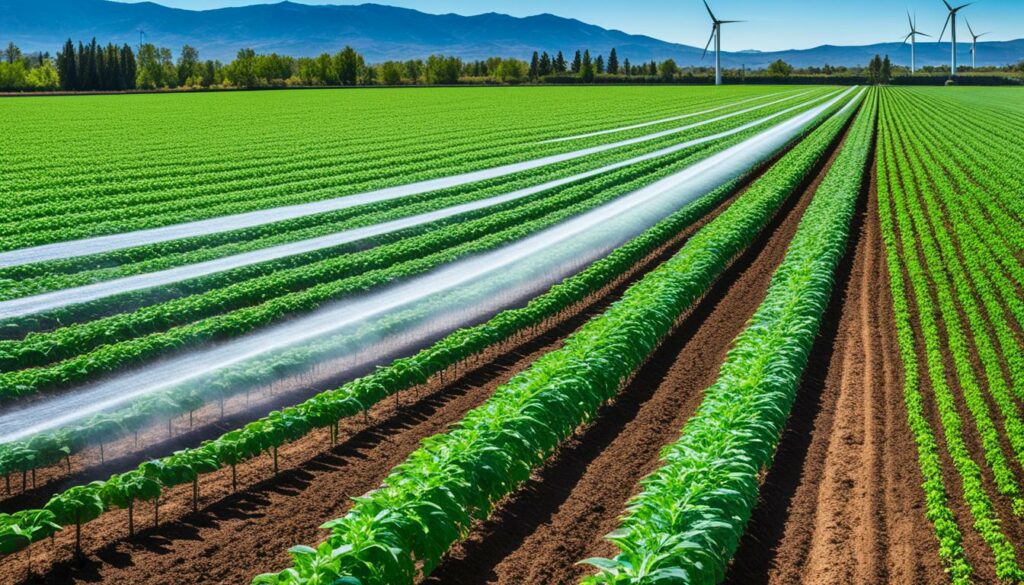
Our current approach to using water in farming is not sustainable. We need to change and use water more wisely. Drip irrigation, for example, saves a lot of water. It uses pipes to bring water exactly where plants need it. This reduces water loss through evaporation and runoff. With the use of modern sensors, farmers can water their crops just enough. This helps to save water without harming the crops.
Due to less water, it’s getting harder to grow crops worldwide. So, the farming methods have to be smarter. A good approach is using cover crops. They help keep the soil in good shape and save water. Leaving crop remains on the soil can also help. It makes the land hold water better. This way, we lose less water to the air.
Plants themselves are also changing to need less water. They can now survive droughts better. Technologies like Aqua-Pam™ are making plant roots get water more easily. This way, the plants use the water well. Thanks to these improvements, farms can use less water. A good example is a farm in Montana that cuts its water use by using efficient watering systems.
Sustainable farming practices are key for keeping our planet healthy. They help with good soil use and looking after the environment. Methods like changing which crops are planted, mixing trees with crops, and caring for the soil are crucial.
Changing the types of crops grown and including many kinds is vital for farming that lasts. Studies show this can make the harvest bigger by 20%. It also means using fewer chemicals in the fields. By alternating what they grow, farmers keep the soil rich. They also control pests better and keep the soil healthy. This way, the land stays productive without harming the environment.
Agroforestry mixes trees and bushes with crops and animals, making things more varied and productive. This way of farming boosts the number of different plants and animals by 30%. Just adding fruit or nut trees can bring in 10% more money. It helps the ground stay together and makes the weather nice for growing things. This stops the land from turning into a desert and helps crops grow better.
Taking care of the soil is at the heart of good farming. Using certain plants and trees can keep the soil healthy. This cuts the amount of soil washing away by half and makes the ground hold water better. Ways of working without digging a lot can also stop soil from running off by 70%. Adding farm animals to the picture make the whole farm work better. All this shows that looking after the soil well means more food and less harm to the earth.
| Practice | Benefit |
|---|---|
| Crop Rotation | Increases yield by 20%, reduces fertilisers by 30% |
| Agroforestry | Increases biodiversity by 30%, adds 10% income |
| Cover Crops | Reduces soil erosion by 50%, improves organic matter by 25% |
| No-Till Farming | Decreases erosion rates by 70% |
Over 70 percent of the world’s freshwater goes to farming each year. To save water, we need new ways to irrigate crops. While flood irrigation is common, covering 85 percent of all fields, drip and sprinkler systems show better results.
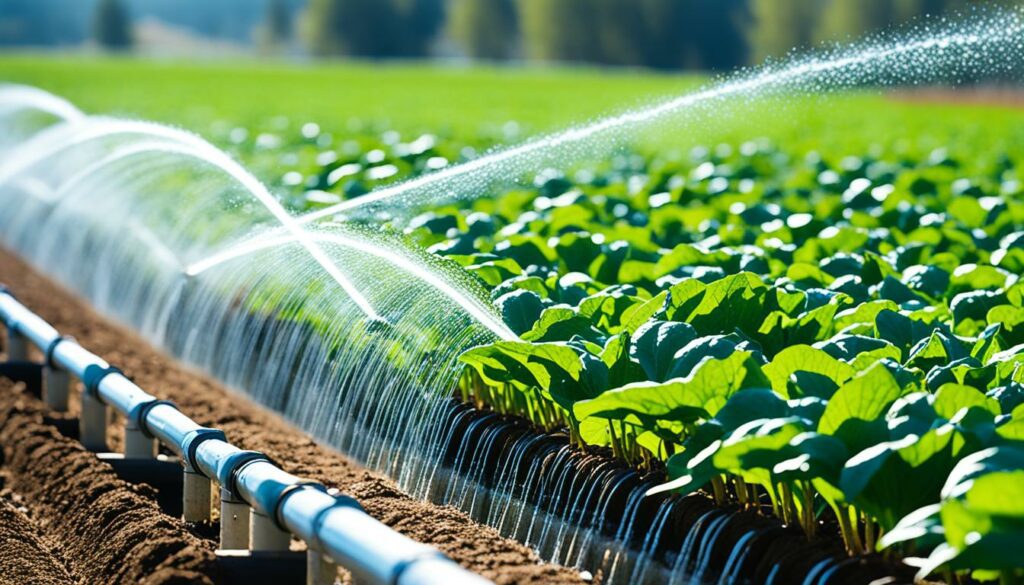
Drip systems bring water directly to plant roots through tubes and emitters. This way, water loss from evaporation and runoff is minimal. Even though drip systems are used on only 3 percent of fields globally, they work well for many crops and soil types.
There’s also gravity-powered micro-irrigation, a type of drip system. It can save half the water and cut down on fertilisers too.
Center pivot sprinklers cover over 30 million acres in the US. They’re good on different terrains and for many crops. These systems may cost more but they spread water evenly, which is vital for some crops.
With subsurface irrigation, water is sent directly to the roots from lines buried in the soil. Little water is lost to the air. This method is perfect for dry areas, boosting crop yields, especially for valuable crops.
Changing from flood to these new methods is very important. Over 20 million acres in the US are still flood irrigated. Many of these are in areas like the Colorado River states, known for little water. Arizona using flood irrigation for 89 percent of its farming highlights the need for more efficient methods. These new technologies help us save water, making farming more sustainable.
Cover crops are key in sustainable farming. They work to improve soil health and hold water better. Farmers plant crops like grasses and legumes in the off-season to enjoy long-term soil benefits.
Cover crops are great for the soil. They boost soil organic matter, which is good for health and saving water. They increase yields in dry areas by up to 22% under irrigation. But, remember, in completely dry areas, they may lower cash crop yields because they use up water too.
If water is scarce, cover crops are even more helpful. They make nutrients work better and stop weeds. This makes the main crops, like corn, grow by 15-22% more if they were irrigated with cover crops.
Also, using cover crops with gentle farming methods saves water and stops erosion. Different cover crops help the soil in unique ways. They change the soil’s tiny life and structure. This chance lets farmers pick the best cover crops for their land.
Here’s a look at some facts that show how cover crops help the soil and farming:
| Condition | Impact of Cover Crops |
|---|---|
| Drylands | Yield increase up to 22% under irrigation |
| Limited-Irrigation | Improved nutrient utilisation and weed suppression |
| Irrigated Fields | Corn and sorghum silage yield increase by 15-22% |
| Erosion Control | Enhanced water conservation efficiency |
In short, using cover crops is crucial for a healthy environment. They make soil better, trap water, and help crops grow more. This all helps towards a sustainable future.
Exploring no-till farming shows how it cuts soil disruption and boosts farm efficiency. It skips ploughing by planting seeds in old crops. This saves soil structure and water, and keeps more organic matter.
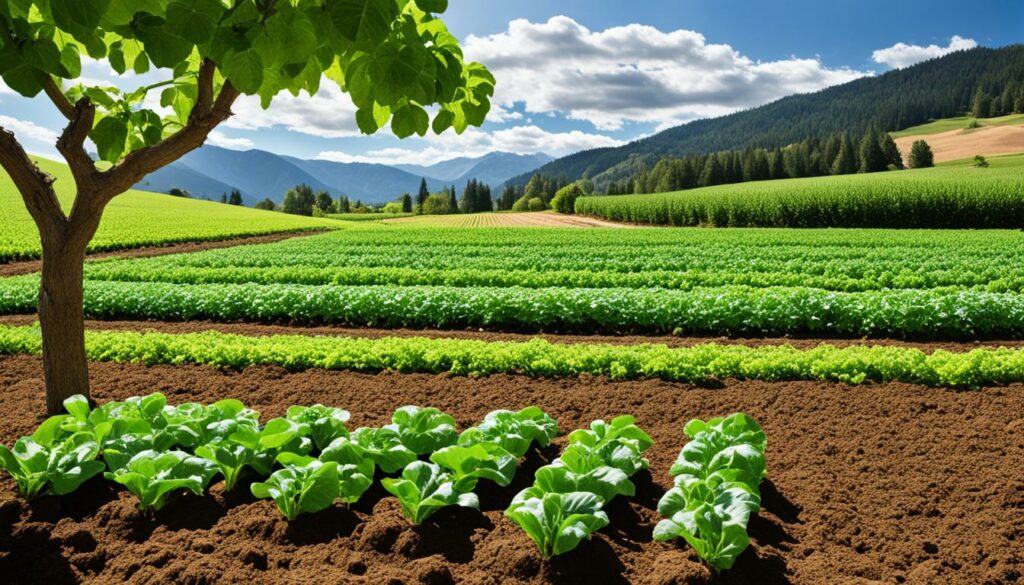
The U.S. reduced soil loss by 43% thanks to techniques like no-till. For example, the Palouse region preserved its soil better using no-till. The area avoided losing its topsoil, unlike other lands.
No-till farming helps nature flourish with more birds and diversity. Economically, it makes a big difference. It saves a lot of fuel and money every year.
Take a look at the table below for more details:
| Metric | Conservation Tillage Impact |
|---|---|
| Fuel Savings (Continuous No-Till) | 4,160 gallons/1,000 acres annually |
| Cost Savings (Continuous No-Till) | Over $8,500/1,000 acres annually |
| Fuel Savings (Seasonal No-Till) | 306 million gallons annually |
| Topsoil Conservation (1982-2003) | 43% reduction in erosion |
| Soil Water Retention | Improved over multiple years |
No-till boosts effectiveness by saving a lot of work and improving water capacity. It shows why it’s a great step forward in farming today.
But, no-till also brings some hurdles, like needing new tools and better ways to deal with pests. Still, its benefits are strong, from saving fuel to storing more carbon. This makes no-till a leader in sustainable farming.
Precision agriculture boosts agricultural efficiency. It makes farming better in many ways. It uses technology like GPS, drones, and satellite images to help farmers use resources wisely.
This can lead to a 4% more crops and a 7% better use of fertilisers. Also, it cuts down on herbicides and pesticides by 9%. This helps protect the environment from too many chemicals.
Precision farming also makes water use 4% more efficient. That’s a lot of saved water. To give you an idea, it equals 750,000 Olympic pools. It shows how important these advancements are for saving water. Plus, it leads to a 6% cut in fossil fuel use and avoids using 100 million gallons of it. This is good for the planet.
It keeps an extra 2 million acres of land from becoming farms. Precision farming does this by making current farmland work better. This means less herbicides and the chance to lower CO2 emissions more. If more farms adopt these methods, we might see even bigger improvements.
| Benefit | Percentage/Quantity |
|---|---|
| Increase in Crop Production | 4% |
| Boost in Fertiliser Placement Efficiency | 7% |
| Reduction in Herbicide and Pesticide Use | 9% |
| Reduction in Water Use | 4% |
| Reduction in Fossil Fuel Use | 6% |
| Cropland Avoided | 2 million acres |
| Water Savings | 750,000 Olympic-size pools |
| Fossil Fuel Saved | 100 million gallons |
| Herbicide Avoided | 30 million pounds |
To speed up the use of precision agriculture, we need government support. Also, more farm income, better infrastructure, and ways to talk to consumers are key. These changes not only help farmers make more money. They also help the earth. They move us towards a better, greener future.
The agriculture sector uses over half of our freshwater worldwide. Yet, it faces growing challenges. With agricultural production set to increase by about 70% by 2050, innovative water management solutions are needed. Technology in water management offers ways for farmers to save water and boost their crop grows.
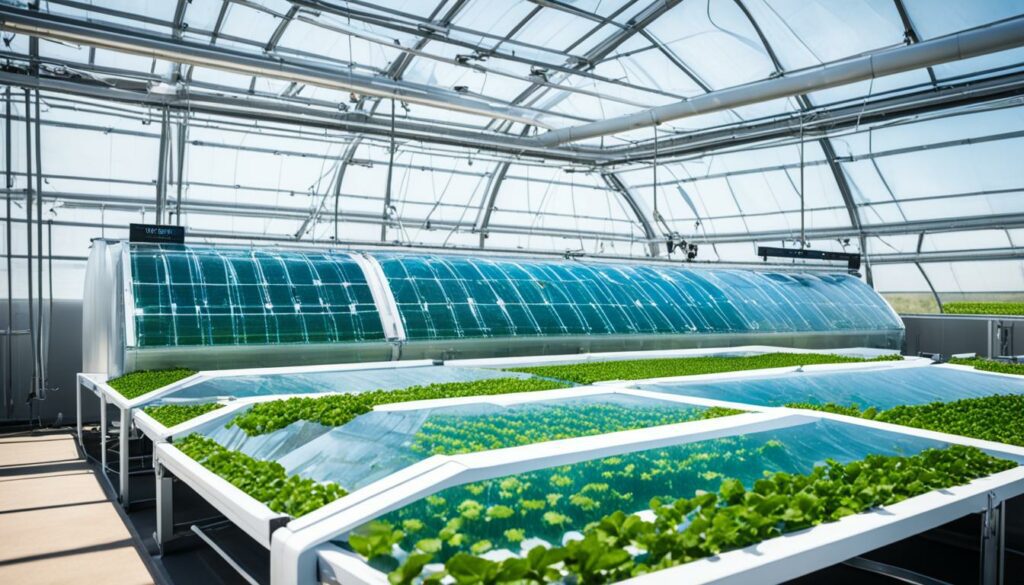
Smart sensors play a crucial role in precision agriculture. They keep a check on soil moisture, weather, and plant health. For example, soil moisture sensors can cut water use by 30%. They stop over-watering by giving farmers data on when exactly their crops need water. This ensures water is used efficiently.
The EOSDA Crop Monitoring tool is a perfect example. It provides access to old weather records, 14-day forecasts, and satellite images for detailed field analysis. This data improves irrigation plans, which means more crop and less wasted water.
Automated irrigation systems work with smart sensors to manage water with precision. These systems change irrigation plans based on up-to-the-minute sensor data. Drip irrigation, for instance, can lower water use by half. This is because it waters the plants’ roots directly, avoiding water loss through evaporation.
Adding AI and machine learning to the mix further improves things. It refines irrigation plans and even suggests the best crops to grow. This in-depth analysis can save up to 15% more water and enhance how efficiently farms run. Also, satellite images and drones help make spot-on changes. This can boost water efficiency and crop yield by an extra 20%.
| Technology | Benefits | Water Savings |
|---|---|---|
| Smart Sensors | Monitor soil moisture and weather conditions | Up to 30% |
| Automated Irrigation Systems | Adjust watering schedules based on real-time data | Up to 50% |
| Precision Agriculture Tech | Optimise water and nutrient use with GPS and remote sensing | Up to 25% yield increases |
By using technology in water management, we not only meet current demand for water but also ensure the future resilience of agriculture. With smart sensors and automated irrigation systems, we lessen our use of limited water resources. This approach also improves how much we can grow on farms.
The USDA’s NRCS is key in pushing for better use of land in farming. They offer more than 160 ways to help farmers use their land wisely. This helps them grow food while keeping the earth healthy for the future.
New conservation practices for 2023 are now out. Here’s what’s included:
Each plan helps with things like soil health, saving water, and taking care of nature. They give farmers worksheets to customise plans for their own land.
These practices are vital for better farming without harming the earth.
The NRCS offers help to farmers wanting to use these good practices. They give advice and money to make it happen. They focus on ways to farm that use less and take care of water better.
Producers using NRCS tools see big improvements in how their soil and water are managed.
| Conservation Practice | File Size (KB) |
|---|---|
| Field Border | 128.99 |
| Filter Strip | 121.01 |
| Hedgerow Planting | 109.03 |
| Mulching | 121 |
| Grazing Management | 845.08 |
| Structure for Water Control | 104.84 |
| Seasonal Water Management For Wildlife | 100.88 |
| Wetland Restoration | 104.21 |
Our world is moving towards a future with less water. By 2050, more than half of us will be living in places with low water. To tackle this challenge, using water markets has become very important. These markets treat water as something that can be bought and sold. This encourages people to use water wisely and effectively. For farmers, this means they can keep growing food even as water becomes scarce.
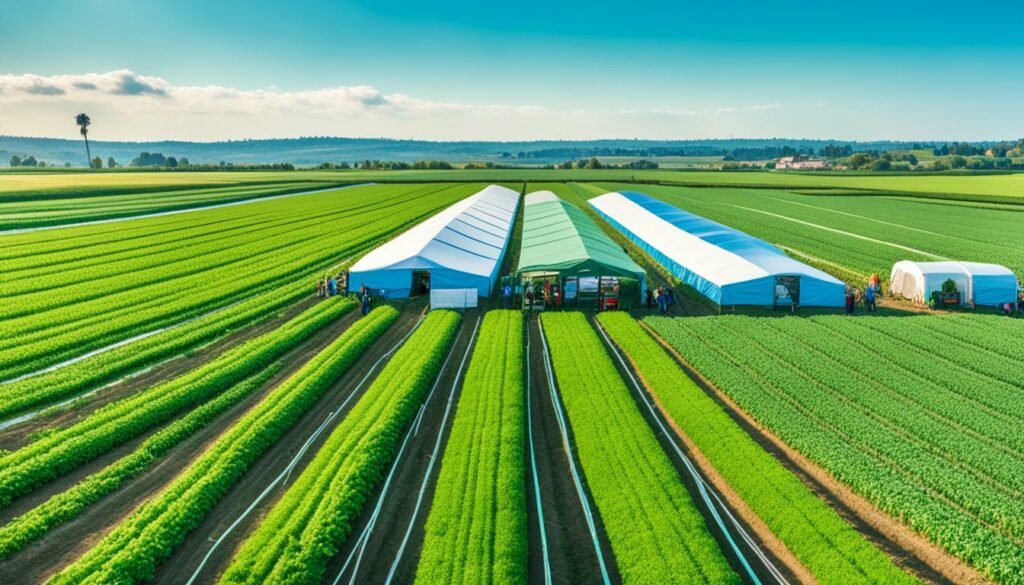
Water markets are all about moving water around through buying and selling. This encourages people to use less water for farming but still keep their farms going strong. A good example is the Murray-Darling Basin in Australia. A lot of the water trading happens there, helping a big part of Australia’s farming. The key is to give farmers and others reasons to use water more carefully.
| Region | Average Annual Turnover (AUD$) | GDP Increase Due to Water Trade | Impact on Agricultural Production |
|---|---|---|---|
| Murray-Darling Basin | 2 Billion | 220 Million (2008-2009) | 4.3 Billion Higher (2006-2007 & 2010-2011) |
Water markets push farmers to use water smarter, leading to better farm practices. In the MDB, they’ve helped the farming economy during droughts. The Australian government supports these efforts by releasing water for farming and nature. They also invest in projects to use water more effectively.
These water markets work together with government plans. These include the APEC Policy Partnership for Food Security and the “Food Security Roadmap Towards 2030.” This teamwork aims to make water use in farming sustainable. They focus on both big and small steps to save water and protect our environment.
Integrating conservation mapping into agricultural strategies is key for resource efficiency. It ensures sustainable land use practices. Around the world, most of our freshwater comes from irrigated agriculture. This shows how important it is to manage water well. Good water management helps save vital ecosystems and keeps biodiversity alive.
Conservation mapping uses maps and smart analysis. This gives a deep look at what the land can or can’t do. It helps us grow crops better on the land we have. This way, we can avoid harming natural habitats. It’s interesting to note that areas with irrigation can be at least twice as productive as those without. So, we need smart water strategies, especially with water scarcity becoming a big issue.
Using conservation mapping helps us find the best ways to use the land. We aim for practices that are both good for farming and protect the environment. It’s important for using water better. This way, we can get more out of each drop, especially where water is not enough. Using water smartly also reduces common mistakes like using too much water or watering at the wrong time.
Many studies have shown how our farming affects the conservation of nature. For example, work by Dobrovolski et al. (2011) shows that farming growth impacts global conservation. Meanwhile, Wilting et al. (2017) looked into how human needs hurt biodiversity. These studies highlight the role of conservation mapping in making farming efficient and sustainable worldwide.
Putting conservation mapping into our farming plans helps us make smart choices for the environment. This approach helps our farm work better while looking out for nature. So, we’re not just using resources well, but also keeping the Earth healthy for those who come after us.
Sustainable agriculture fights climate change and protects nature. By using eco-friendly ways, we gain lots for our ecosystems. This includes food security for everyone around the world.
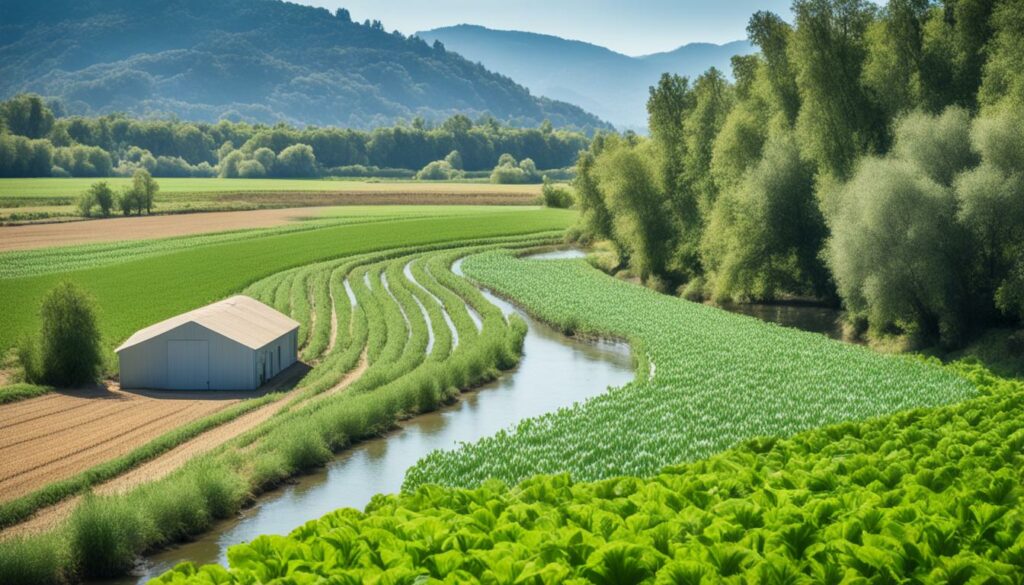
Sustainable farming reduces harmful gases a lot. About 30% of these gases come from turning forests into farms. But, methods like crop rotation and no-tillage keep carbon in the soil. This means we cut down emissions. It’s very important because we’re losing forests to create new farming lands.
Sustainable farming is key to more varied and healthy life forms. Bad farming practices have made soil and water dirty, and hurt plant and animal life. But, farming well, like using friendly ways to handle pests and growing different crops together, protects nature. For example, much of Australia’s wetlands struggle because of poor farming choices. But, investing in farming that cares for the land can make these places thrive again.
In Kenya, a project by The Nature Conservancy is showing great results. By helping farmers improve how they look after cattle, they’re not only helping nature but also the local people.
| Ecosystem Benefit | Example |
|---|---|
| Reduction in Greenhouse Gas Emissions | Sequestration of carbon in soil through no-tillage and cover cropping |
| Promoting Biodiversity | Agroecological practices reducing chemical use and supporting diverse ecosystems |
Keeping water safe and used well in farming is very important. There are many rules on using water, such as the ones in the FSMA. They help keep fruits and vegetables safe from harmful substances. The FDA has set up strict rules for farmers to follow. This ensures water used in farming is clean and safe.
The FDA’s rules about water use are very detailed. They cover things like making sure the water is clean, checking the systems, treating the water, and testing it properly. Farmers must follow these rules when they use water for things like watering crops, spraying, or washing produce. The rules aim to stop harmful bacteria, such as E. coli, from getting on the food.
Meeting the FSMA standards is key to keeping food safe. Farmers must inspect their water systems at the start of each season. They also have to reduce the chances of water getting contaminated. If needed, farmers should add chemicals to their water to make it safer. They must check their water and keep detailed records to show they’re following the rules. This approach helps farms use surface water safely before the deadlines.
| Farm Size | Compliance Deadline |
|---|---|
| Large Farms | April 7, 2025 |
| Small Farms | April 6, 2026 |
| Very Small Farms | April 5, 2027 |
If the water on a farm isn’t safe, the farm must fix that right away. This system helps make sure water on farms is used well and safely. It encourages farms to follow the FDA’s rules and to use water wisely.
Looking at real-life cases shows the big wins of eco-friendly farming, especially in water use. These cases highlight that small changes can mean big jumps in handling resources right and growing crops better.
Steve Burke changed his farm’s watering ways with a new pipeline in Montana. This move boosted how well water was used and made sure plants got water when they needed it most. Using new water systems, farms waste less water, helping the planet and saving money.
There are also big wins from mixing farming with keeping cows and wisely using fields in Montana. This swapping of cows from spot to spot helps the ground stay good and stops it from wearing out. Having animals and crops mix means the farm stays healthy, promoting a farm that can last for years.
A farm near Bangalore is doing great with drip watering, using less water and getting more crops. And a farmer in rural Karnataka is using less groundwater thanks to saving rainwater. By just covering the ground with mulch in Kanakapura Road, they’re not needing to water as much—a 40% drop!
Places like Vriksha show the way by using smart water methods. They cut costs, help the environment by saving water, and use less of what’s under the ground. These ways show we can farm today without hurting our chance to farm in the future.
Sustainable agriculture keeps the ecological balance by saving resources. It avoids harm to the environment. Methods include crop rotation and precision agriculture, making farming better for the planet.
Water-efficient farming helps tackle the world’s scarce water issue. With our freshwater supply limited, managing water well is critical. This approach lets us grow enough food without harming future water supplies.
Global water scarcity makes growing crops harder. Less water for irrigation and processing means farmers must be smarter. They use techniques to make sure their crops still thrive, even with less water.
Crop rotation, agroforestry, and soil management are key. These techniques keep the soil healthy, save water, and support plant and animal life. They are important for long-term farming success.
Drip and sprinkler systems and subsurface irrigation save water. They are efficient and reduce water waste. These modern methods are good for the environment, making farming greener.
Cover crops protect the soil and lower erosion risk. They add nutrients to the earth, improving its structure. This means less water is needed, and plants can grow healthier with these natural covers.
No-till farming keeps the soil undisturbed, which is great for crops. It also saves water. By not ploughing the land, the soil stays rich, absorbs more water, and stops erosion.
Precision agriculture uses tech to use water, fertiliser, and seeds as needed. It cuts waste and makes farming smarter. This saves resources and is good for the planet.
Smart sensors and automated systems manage water use. They check what the plants need and adjust the water supply. This ensures water is used efficiently without extra waste.
The NRCS has over 160 practices, including water conservation. It helps with smart irrigation and managing the soil. These efforts are part of making farming sustainable in the long run.
Water markets make water a valued resource, encouraging careful usage. They help farmers use water better. This means farms can be more productive while saving water.
Conservation mapping uses data for better land use. It advises where to grow crops without harming nature. This approach helps farms use their land wisely, protecting nature and being efficient.
Sustainable farming helps reduce greenhouse gases and supports wildlife. By using practices like cover crops, farming is more eco-friendly. It’s good for the earth and the plants and animals that live here.
The FDA’s FSMA ensures water in farming is safe. It includes testing and treating water to avoid contamination. These rules back keeping water use efficient and safe for farming.
In Montana, Steve Burke’s irrigation pipeline has cut water use and improved farming. Cattle and crop rotation methods show benefits in managing land well. It proves that with good practices, farming can be more productive and kind to the environment.